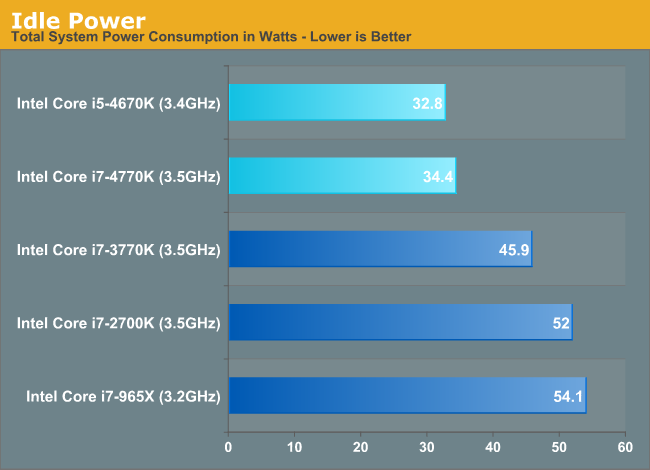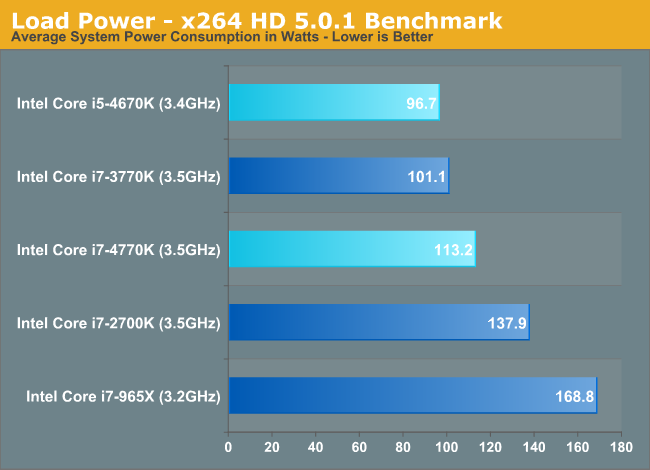The Haswell Review: Intel Core i7-4770K & i5-4670K Tested
by Anand Lal Shimpi on June 1, 2013 10:00 AM ESTPower Improvements
Although Haswell’s platform power is expected to drop considerably in mobile, particularly with Haswell U and Y SKUs (Ultrabooks and ultrathins/tablets), there are benefits to desktop Haswell parts as well.
There’s more fine grained power gating, lower chipset power and the CPU cores can transition between power states about 25% quicker than in Ivy Bridge - allowing the power control unit to be more aggressive in selecting lower power modes. We’ve also seen considerable improvements on lowering platform power consumption at the motherboard level as well. Using ASUS’ Z77 Deluxe and Z87 Deluxe motherboards for the Haswell, Ivy and Sandy Bridge CPUs, I measured significant improvements in idle power consumption:

These savings are beyond what I’d expect from Haswell alone. Intel isn’t the only one looking to make things as best as can be in the absence of any low hanging fruit. The motherboard makers are aggressively polishing their designs in order to grow their marketshare in a very difficult environment.
Under load, there’s no escaping the fact that Haswell can burn more power in pursuit of higher performance:

Here I’m showing an 11.8% increase in power consumption, and in this particular test the Core i7-4770K is 13% faster than the i7-3770K. Power consumption goes up, but so does performance per watt.
The other big part of the Haswell power story is what Intel is calling FIVR: Haswell’s Fully Integrated Voltage Regulator. Through a combination of on-die and on-package circuitry (mostly inductors on-package), Haswell assumes responsibility of distributing voltages to individual blocks and controllers (e.g. PCIe controller, memory controller, processor graphics, etc...). With FIVR, it’s easy to implement tons of voltage rails - which is why Intel doubled the number of internal voltage rails. With more independent voltage rails, there’s more fine grained control over the power delivered to various blocks of Haswell.
Thanks to a relatively high input voltage (on the order of 1.8V), it’s possible to generate quite a bit of current on-package and efficiently distribute power to all areas of the chip. Voltage ramps are 5 - 10x quicker with FIVR than with a traditional on-board voltage regulator implementation.
In order to ensure broad compatibility with memory types, there’s a second input voltage for DRAM as well.
FIVR also comes with a reduction in board area and component cost. I don’t suppose this is going to be a huge deal for desktops (admittedly the space and cost savings are basically non-existent), but it’ll mean a lot for mobile.
No S0ix for Desktop
You’ll notice that I didn’t mention any of the aggressive platform power optimizations in my sections on Haswell power management, that’s because they pretty much don’t apply here. The new active idle (S0ix) states are not supported by any of the desktop SKUs. It’s only the forthcoming Y and U series parts that support S0ix.










210 Comments
View All Comments
Da W - Saturday, June 1, 2013 - link
It confirms Temash tablets will be the GPU+CPU performace / power / price ratio to beat.takeship - Sunday, June 2, 2013 - link
At 8-15W. What size market is that again? It's like saying Amtrak has a better cost/distance than a Prius. Yes, but so what?Dal Makhani - Saturday, June 1, 2013 - link
its not disappointing at all, its gains, and any gains matter on an annual schedule. As long as it beats Ivy by any percentage, its progress. You know Intel's goals are not IPC related as much as mobile, so dont rant when all the facts are in front of you.peterfares - Saturday, June 1, 2013 - link
You must have missed the part where S0ix isn't available on the desktop parts. How about you wait until the MOBILE and ULV processor tests are in before you start ranting.Jammrock - Saturday, June 1, 2013 - link
The point of Haswell is not to drastically improve performance. Haswell is designed to move x86 into the tablet and mobile market with drastically improved idle and low power performance. Skylake, in roughly 2015, will likely be the next big performance boost.Hector2 - Sunday, June 2, 2013 - link
"Haswell" isn't going into tabletsKlimax - Sunday, June 2, 2013 - link
It does - Surface Pro class.(TDP 10W)thebeastie - Sunday, June 2, 2013 - link
Well I am happy to see the 4th gen release. And yay PCI is now officially gone. Shouldn't there be a memorial ceremony? And maybe a trophy? :)Kudos to the first posters looks like they some what actually read the review, even tho I don't know if I agree with your comments.
klmccaughey - Monday, June 3, 2013 - link
Yes, it is great to see PCI finally dead and buried. It's been a bit like having a tow bar on a ferrari this last few years. Hoorah for the death of PCI!!! :)GullLars - Sunday, June 2, 2013 - link
Where this will probably shine is in mixed workloads. Not overclocking for gaming or production.It will be easier to put Haswell into (G)HTPC builds at mini-ITX and µATX formfactors and keep noise down while still having great burst performance. The 4770K seems to be not worth it for overclockers that have got good Sandy/Ivy chips.
I think i may upgrade my parents living room PC to something like a mini-ITX build with i3-42xxT, and just transfer the SSD (Force GT 120GB) and RAM (8GB 1600 SO-DIMM). It should be a substantial upgrade from E-350 and almost fit the same power envelope for their use cases.
I'm looking more forward to more info on Ivy-E. I'm happy with my 3930K with a decent OC, but if Ivy-E can bring the power/performance ratio down without bringing performance down or heat issues, i might upgrade :)